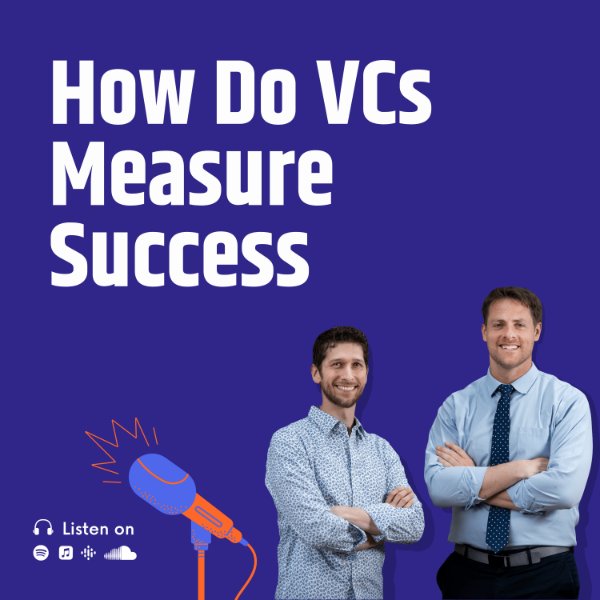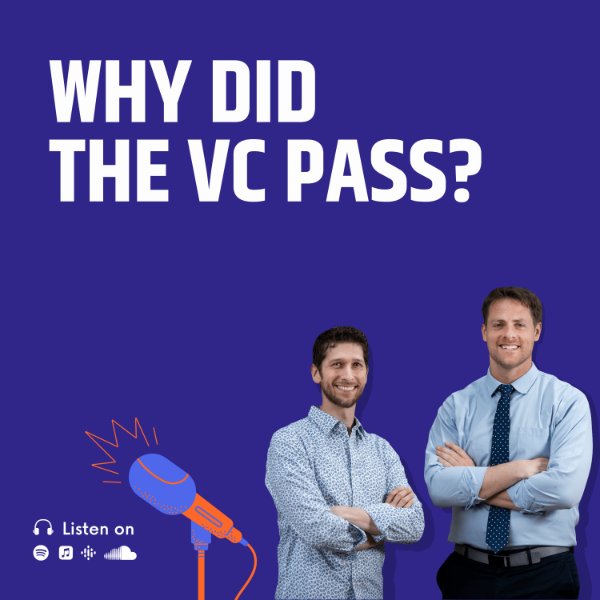Jon: Our last podcast, we talk about valuations of seed and what I'm seeing in Utah. And the interesting thing is now Carta for those of who don’t know Carta, one of Peter, as an investor, full disclosure, it's a one investor.
Peter: Investor, full disclosure. Jon introduced me to Carter.
Jon: I'm proud of that. So I want to, I want to introduce you to like ten more Carta’s
Jon: So the, the Carta is interesting because their deal, they've got actual data. They're there you can track of everyone's legal docs the valuations percent of ownership and so they are in a unique spot to give data that other people aren't giving. The interesting thing I think about this is though, is that what they're saying is that valuations for Q2, in particular the seed and this probably is global.
Jon: I'm assuming valuations in Silicon Valley might be different than Utah still, but when I'm looking at the number.
Peter: I'm pretty similar.
Jon: I am. Shook Yeah, Shook Shook for sure. So if we go to Q2 2023, the median pre money valuation by stage and quarter is 13.3 million. Yup. And I know even seasoned founders who've had an exit 10 to 20, 30 million are currently raising at a 5 million.
Peter: Yeah, better than pre-seed or seed because there's a distinction these days. Pre-seed Pre-seed. But this is seed.
Jon: This is seed. wait wait. Every they go see improvement evaluation for seed gets our seed. Okay. Never mind that.
Peter: I feel like these these iron range for seed you know 10 to 15.
Jon: So in Utah you would agree it's back.
Peter: In the good old days that's what like a series A was valued at.
Jon: When I first started. Someone would say they had $1,000,000 premium valuation and the investors in Utah would lose their minds. Well, there's no hard money loan. You're not guaranteeing your house, not.
Peter: Guaranteeing your house and your.
Jon: Firstborn no collateral for.
Peter: For my 50 K investment.
Jon: yeah. You're not profitable yet, Right. Right. Yeah. So I guess the last one we talked about. Sorry. Separation. Proceed. Proceed and proceed. Our last podcast, we should have been more pre-seed.
Peter: We were more Pre-seed.
Jon: We just talked about someone I see that the so they go through seed series, so they're saying that in a seed deal the average median valuation right now is 13.3 million. It's down from 15 million from a year ago.
Jon: From 2020, which was about 8 to 9 million.
Peter: Yeah. So I mean, it's it's edging upwards. How much of that though is inflation, right.
Jon: Let's assume inflation will be 20%. Yeah. So it's still a little higher.
Peter: That may have a little bit of it. So what the data doesn't show that I would love to see.
Jon: Is volume and we do maybe we should do a special podcast with Karla and we can have all of Peter's and John's questions answered. Maybe we can get them to sponsor the podcast.
Peter: But they're not going to be on this podcast today, so.
Jon: Not today. Let's just go through. I'm just planting seeds.
Peter: You all think? Audience Do we do it?
Jon: I think art has a lot of interesting data.
Peter: They have tons of super interest.
Jon: But even if you look at like series A, series A, even with all this like downturn. Yeah, even in the lowest downturn of the end of Q4, which the valuation was 36.5 million for a series. A Yep, it's still up 40 million, whereas you one 2020 was 29 million. So again, that's almost 30 to 40% increase. Yeah, but then again, maybe that's part of.
Peter: The problem though is that this is nationwide because I think California's startups like tend to demand a slightly higher valuation. What I'm seeing is generally like Pre-seed is like five seed is like ten series A is like 20, right?
Jon: How do you count the traction for in revenue for each of those? But it would be no revenue.
Peter: Raises like no revenue, but maybe like an ally seed is like 100 to 500 k revenue somewhere in there.
Peter: through the series is like 1 to 2 million in revenue. Okay. And revenue or RR or something equivalent.
Jon: Logo based on what we saw in the last podcast is that I've got a friend who's raising right now, I think at a 35 million post-money valuation and I believe they're doing about a million in revenue, almost like a 35 X multiple of revenue.
Peter: Yeah, it depends on how fast they're growing.
Jon: But again, this founder has a very juicy prior exit. Yeah.
Peter: Yeah. I mean it's not Yes. Those like in range. Yeah. Like 20 to 40 series a number in that range.
Peter: Yeah. But again going back to this data and this is going to be my question with all of these data points is volume, volume of deals. because I would it would not surprise me if the vol like valuations remain relatively flat. The volume declined.
Peter: And the reason for that is we've talked about on other episodes, but there's still a ton of money out there floating around, right? Investors still have to put the money to work, but they're going to be more cautious. They're doing fewer deals. Generally speaking, I've sitting on their hands more.
Jon: I've heard that LPs are asking VCs not to do capital calls.
Peter: I haven't heard that.
Jon: Okay. Or that they prefer not to have the capital call at the current moment.
Peter: That may be the case.
Peter: I mean, I could see situations where LPs are like, no pressure to put money to work right now, right? That sort of thing.
Peter: And I think a lot of VCs are also hesitant to put money to work right now because they are a little bit anxious about who's going to fund the next round. But like if you've hit the metrics, you've got a great business, you're growing like all of those things, like, Yeah, this is we'll write you a check and they'll do it at similar valuations.
Peter: And part of the reason for that is because if you think about the VC math that I walked through on our other episode, which you have and listen to, go and listen to it, but like for a series, a fund they want to own, they want to buy like 25% of the business when they invest. And so if they're going to write, you know, let's say they write a $10 million check, which is not unheard of.
Peter: Right. For a serious by a fund. It is they write a $10 million check at a $30 million pre. They're going to end up owning 25% of the business with 40 million post write. And then they're hoping that like after dilution and everything else, they're going to get down to like 15% ownership in the company companies that gets acquired for like $2 billion.
Peter: It goes public for like $2 billion. So it's a win for them right now. And 15% of that, that's 300 million. Their funds are usually about 300 million in size. They return their fund like it's just basic, you know, basic math there. So it's like like, why would valuations change a whole bunch off of that? Right. And if the fund here's what's interesting is that if funds end up raising less money to fund sizes contract, I believe that would have a bigger impact on early stage.
Jon: Valuations are fantastic.
Peter: That a number of then what happens in the public markets. So that's a great question. And the reality is probably what will happen is a number of funds will contract, but not the fund sizes.
Jon: Okay. Yeah, that'd be my guess. Yeah.
Peter: And then I mean that that plays with what's happened historically, which all of this goes back to support Why valuations at the early stage are flat.
Jon: Yeah. Got it. So I think the one thing from their data so they go into series BCD and I may I'm ignoring this, but maybe we should cover it. Yeah, we.
Jon: It. But the part that I find interesting is for generally everything is up. I think if you adjusted for inflation from 2020.
Peter: Everything is flat.
Jon: Yeah, things look a lot more stagnant. But the big difference is series A amount of capital invested. The peak first Thursday was 1212 million according to Carta. In 2020 it was 8 million. But right now it's between 6.5 and 7.4 million. So even for adjusted for inflation, the amount of capital going into these companies is down way down over like 50%, more than 50%, I think if you include inflation.
Peter: Yeah, that's interesting. That would actually be an argument against my earlier point that like shrinking fund sizes was a result. And yes, I read the data. so that would go against my argument that like smaller check sizes would result in lower valuations. But I don't know, like it's not surprising that the that round sizes are smaller. It could also be that the funds remain the same in terms of their check size.
Peter: It's just that there are fewer co-investors alongside them. Right? It's washed out a lot of smaller funds. Individuals like it used to be like you know, everybody was flush with cash and they were all trying to get into the hot deals and companies are raising. Yeah, so there is BCD, etc.. Those are going to be impacted more by by public markets, right?
Jon:
Peter: So the lead I mean, a lot of people write the same the same check at the same valuation in the seed stage because they're like, look, public markets are not going to impact this thing for another ten years. And I don't know or I have no idea where public markets are going to be in ten years. So like valuation just doesn't matter in relation, right.
Peter: But once you get to the series B, the series C, the series D, the likelihood of of that happening matters even more. And you could argue, well, what series B is still really early. But the reality is, is that the guy or the woman venture investor that's going to invest or growth equity investor is going to invest in the series C is going to be very cognizant about what's happening at the at the at the IPO.
Peter: And so they're going to, you know, be setting valuations that make sense for them at the Series C and the Series B, Investors have to be wary of how that Series C investors are going to be thinking. And so that will impact Series B. Also, Series B is just just a tremendously hard round, in my opinion, to raise because it's like it's like you're in your like teenage years, you know, you figured out a lot of stuff, but you're not really a big full fledged company.
Peter: so there's still like a decent amount of risk on the business in most cases, but I guess that's a whole other whole other topic. I think if you look at the charts for Cada, where it's interesting thing is that Q2 to Q3 and then Q4 especially rolls around in 2022 and you see like all valuations just fall off a cliff.
Peter: For series Disney in particular. And I think actually, you know, if you look at public markets, public markets like fell off a cliff even earlier than that. And I think ultimately what's happening is you had a bunch of like hangover of deals that were in negotiation and just hadn't closed and so forth from the end of 2021, because from my my viewpoint, like things like the the music really kind of stopped, I would say end of Q2, end of 2021.
Peter: but you were still hearing echoes of the music through Q1. and then like there were no more echoes by Q2. And so I was just wrapping up deals that were already in negotiation and so forth. And then, you know, that's where you see these huge drops in Q3 and Q4 as the only people that row raised money were the ones that like had to.
Peter: And the other thing that I bet would be interesting is like how many of those deals on their this goes back to almost a volume question were like convertible notes or or flat rounds that may not have been like captured in the data set because what they did is they just reopened the last round. And so that's so I'd be curious to know, like what's his volume numbers look like?
Peter: And then also like, did they capture like if I, if I just reopened the series D round that I raised in 2021 and every open in 2022 and let people, you know, put more money in at same terms like does that get captured as a continuation of that valuation or is that not get captured in the data set?
Peter: so, so yeah, so I think there is those aspects and then the other thing that's interesting is you see valuations drop a ton. What's not entirely clear is like I know for a fact that there were a lot of deals done of the Series C and Series D stages where we talked about the seminal episode they raised at on paper flat rounds, but in reality they issued so many warrants and preferred returns and other structural mechanisms that effectively, like they were massive down rounds or like, you know, multiples on liquidation preference and they were effectively down rounds.
Peter: And so I don't know how much of the data would have gotten captured in in that with Carta. Theoretically, Carta could run for on any valuations and include that sort of stuff. But but I don't know if they actually did for for this data set anyways. Those are some of my like thoughts on on some of the data there.
Peter: But yeah, super interesting. Nice to see that it's kind of flattened out and starting to come back up, which also again mimics public markets that have for the most part and flattened out and are making, you know, a slow and steady rise, not without some bumps here and there. So, you know, it's like people say like growth equity is going to mirror public markets and probably be 3 to 6 months behind, maybe more, maybe 3 to 9 months is probably a little more accurate, for a number of reasons.
Peter: But yeah, I don't know that the latest stuff didn't, didn't really surprise me. And what I've been hearing and, and I've said this to a lot of people is that, talking to a lot of growth equity investors, they're anticipating a lot of companies will start coming to market probably in Q4, Q1 of next year, Q4 of this year, Q1 of next year.
Peter: And because everyone's anticipating that, I'm anticipating that and we're already seeing this that companies are starting to come to market now trying to preempt it. and I think a lot of VCs, especially in the growth equity space, are really excited about that because they've kind of been sitting on their hands the last like nine months. I know one one growth equity shot that they told their whole analyst associate team like go play golf because we're not doing deals.
Peter: but they're excited for that to roll around because they're going to be a lot of very high quality companies, high quality assets coming to market, raising money and needing to do so. And because of that, there's anticipation that they'll be able to come in at lower valuations or with more structure that provides more upside or less downside.
Peter: and so I think a lot of growth equity funds are anticipating being pretty active and it won't surprise me evaluations remain relatively flat from where they are today throughout that period. so anyways, there might be more than you on it, but those are my off the top of my head thoughts.
Jon: This is great. I think it will be excited to see what happens when the market's open up, but luckily I feel like it's not affecting the seed pre-seed through.
Peter: Day as much except for the volume thing. I do think volume is down.
Jon: And it would be interesting to see all the warrants components.
Peter: Yeah, I think that's interesting. And I also wonder too, like how many of these companies that are getting funded are like new businesses versus like established ones, right? Like we talked about on our other episode, how there are there are founders that are really struggling to raise right now right. And so like, I also wonder, like how many of these deals are valuations are relatively flat are are relatively new companies that didn't raise obscene amounts of money in 2021.
Jon: Or would have extra mechanisms to to adjust their valuation. Sure. Right. But would your guess be it'd be curious to see how many were existing prior to the down round and what mechanisms would make their actual current market rate because there might be then a lot more, you might see more of a decrease for seed in three days.
Jon: And if that's the case.
Peter: Yeah, but you're not you're not likely to put a ton of warrant coverage on a seed or series A company. Yeah. So that's more of like a growth equity type thing.
Jon: All right. Thanks for watching. I got a venture capital firm and you can check out the podcast that Peter Harris and I do. And we'll join you on the next one and make sure you let us know your your comments in here, here on YouTube. Thanks, guys.





